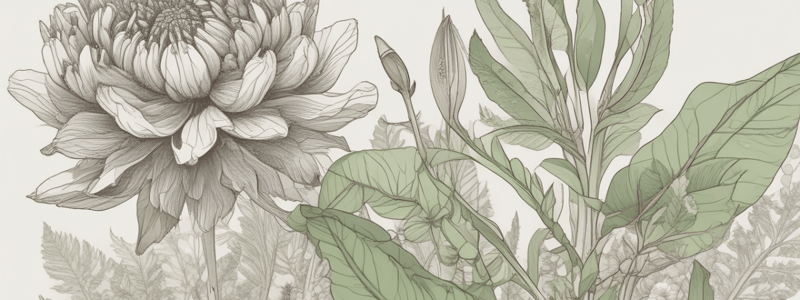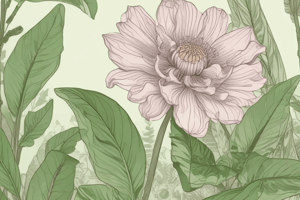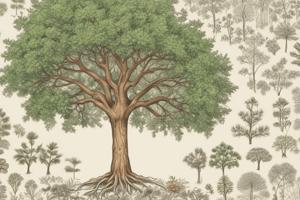Podcast
Questions and Answers
What do ferns and mosses have in common?
What do ferns and mosses have in common?
- They are only found in cold climates
- They grow from spores (correct)
- They have needle-shaped leaves
- They produce flowers
What is unique about whisk ferns?
What is unique about whisk ferns?
- They don't have real roots or leaves (correct)
- They produce cones
- They have needle-shaped leaves
- They are only found in cold climates
Where are liverworts and hornworts typically found?
Where are liverworts and hornworts typically found?
- In cold, dry deserts
- In shady areas with dense forests
- In warm, moist, tropical regions (correct)
- In coastal areas with high winds
What is a characteristic of non-flowering plants?
What is a characteristic of non-flowering plants?
What is the characteristic feature of horsetail plants?
What is the characteristic feature of horsetail plants?
How do ferns and other non-flowering plants that grow from spores reproduce?
How do ferns and other non-flowering plants that grow from spores reproduce?
What is the meaning of the word 'gymnosperm'?
What is the meaning of the word 'gymnosperm'?
What is unique about cycad plants?
What is unique about cycad plants?
How long can gingko trees live for?
How long can gingko trees live for?
What is another name for the gingko tree?
What is another name for the gingko tree?
Study Notes
Non-Flowering Plants
- Ferns are green plants that grow in damp places and don't have flowers.
- Non-flowering plants have been around for millions of years and are some of the most ancient plants on Earth.
Types of Non-Flowering Plants
- Ferns, liverworts, mosses, hornworts, whisk ferns, club mosses, horsetails, conifers, cycads, and ginkgo are types of non-flowering plants.
Non-Flowering Plants from Spores
- Ferns grow from spores instead of seeds.
- Spores are tiny cells created by the plant, released into the air or water, and travel away from the original plant.
- Ferns, whisk ferns, mosses, liverworts, and hornworts grow in damp areas.
- Whisk ferns don't have real roots or leaves.
- There are over 12,000 different kinds of moss, which often covers the ground like a velvety rug in shady and moist areas.
- Club mosses have leaves shaped like needles and small leaves that make clusters in the shape of a cone, found mostly in tropical mountain areas.
Liverworts and Hornworts
- Liverworts and hornworts are spore-producing plants that grow on top of damp rocks and soil, and sometimes on tree trunks in damp areas.
- Hornworts are one of the oldest plants on Earth.
Horsetails
- Horsetails reproduce by spores and have no flowers, resembling a horse's tail.
- They are also called snake grass, horse pipes, or mare's tail.
Non-Flowering Plants from Seeds (Gymnosperms)
- Conifers, cycads, and ginkgo are gymnosperms, meaning 'naked seed', as their seeds aren't developed inside parts of flowers.
- Conifers have cones instead of flowers and needles instead of leaves, including pine, redwood, and hemlock trees.
- Cycads have very thick stems and large, divided leaves, and have been around over 200 million years.
- Gingko, also called the maidenhair tree, is a non-flowering plant that reproduces with seeds, with fossils of gingko leaves found to be over 270 million years old.
Studying That Suits You
Use AI to generate personalized quizzes and flashcards to suit your learning preferences.
Description
Learn about non-flowering plants, their ancient history, and different types including ferns, mosses, and conifers. Discover how they grow from spores, not seeds.




